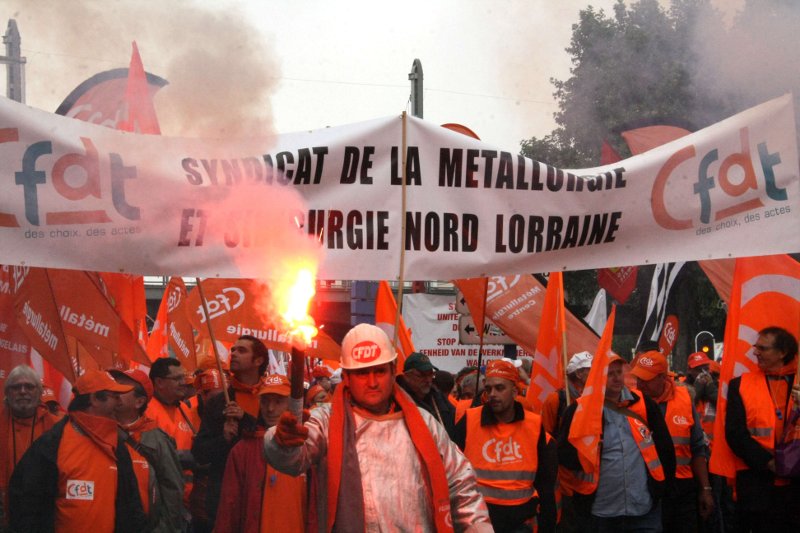On September 29 more than 100,000 trade unionists from 27 different countries marched through Brussels in protest against the austerity measures being imposed by governments across the whole of Europe. The turnout was far greater than the trade union organisers had expected and it reveals the seething anger that is spreading throughout the whole of the European working class.
“The most serious attempt to dismantle the welfare state, the ultimate attack against the unions” this is how the former head of the study bureau of the Belgian Christian union, ACV/CSC, summarised the spate of austerity packages being introduced across Europe. Without exception, all the European governments have taken the path of austerity plans involving slashing budgets, increasing taxation, cutting pensions. Even the Socialist-led governments elected on a mandate of defending the workers in Greece and Spain have capitulated to the pressures of “the markets”, i.e. to capitalism in crisis. Bailing out the banks has cost the UK government 500 billion pounds and in the EU 1700 billion have been handed over to the banks. Public debt in the EU soared from 7,300 to 8,700 billion euros between 2007 and 2009.
Now the workers are being forced to pay for those extravagant bail-outs. Workers in Europe are suffering a double punishment. They are those who feel the brunt of the wage cuts, sackings and increases in the age of retirement as a result of the recession. Despite all the talk about “stabilisation of the EU economy” workers do not feel the recovery. Over and above all this the workers now also have to suffer the draconian budget cuts. This astronomical amount of public money that has been transferred to the rotten financial system is the equivalent to a gift of 3000 euros per inhabitant to the banks within the EU. One union has calculated that this amount is as much “as the total expense on education and health within the EU” or “equal to the joint total public spending of Germany and Spain”! And this was before the new bail-out in Ireland…
The more than 100,000 trade unionists who marched through Brussels during the European Day of Action were moved by their desire to fight against this ominous future. Although quite uneven in composition, it was a truly international demonstration with delegations from more than 27 countries. In ten other countries the unions responded with strikes and marches to the call for the European-wide day of action. For many people present the demo was a real morale booster.
The flavour of French class struggle
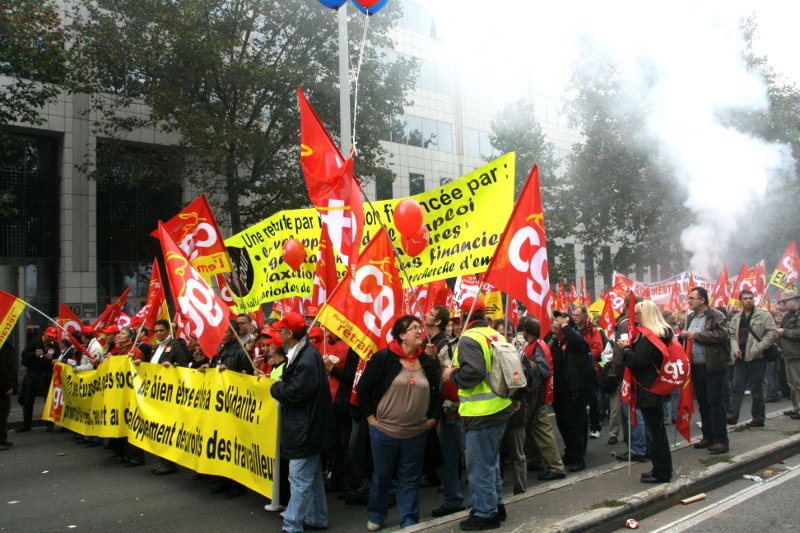 Apart from the massive contingent from the Belgian unions, the French workers formed the second biggest group. Seven hundred busses were needed to bring the battalions of CGT, CFDT and other activists to the “capital of Europe”. Approximately 35,000 French workers brought to Brussels the flavour of the growing struggle against Sarkozy. The level of class struggle is growing in this key country of the European Union, with an ever growing number of workers participating in the demonstrations against the increase in the age of retirement.
Apart from the massive contingent from the Belgian unions, the French workers formed the second biggest group. Seven hundred busses were needed to bring the battalions of CGT, CFDT and other activists to the “capital of Europe”. Approximately 35,000 French workers brought to Brussels the flavour of the growing struggle against Sarkozy. The level of class struggle is growing in this key country of the European Union, with an ever growing number of workers participating in the demonstrations against the increase in the age of retirement.
As one French worker said, “La peur change de camp - fear is changing camp” in France. On March 23, 700,000 protested in the streets, one million on May 27, 1.4 million on June 24, more than 2.5 million September 7 and more than 3 million on the fifth day of action on September 23. The scandal and crisis-ridden government of Sarkozy only requires one very good push to fall. If the union leaders were serious in their struggle they would declare an unlimited general strike on October 12, the next day of action.
Significant was the presence of a compact and sizeable group of workers from the Grand Duchy of Luxemburg. The government of Luxemburg has just decided to introduce a 500 million euro cut in spending every year until 2014. On September 16, 5000 workers took to the streets of the capital. The unions had only expected 3000 to turn out and protest against the withdrawal of child benefits and study allowances for trans-border workers. This group represents 44% of the whole workforce in Luxemburg. More actions are planned for the autumn. If the workers of Luxemburg are starting to move, then something must be changing in the minds of the whole of the European working class.
European working class on the rise
 The Italian metal workers of FIOM A closer look at the composition of the march provides us with a map of the class struggle in Europe today. Very significant, although not as numerous as the French delegations, were the groups who came from Eastern Europe. The workers of Romania, the Czech Republic and Latvia are spearheading a revival of the trade union movement unseen since the restoration of capitalism in their countries. A general strike of the public service workers in Romania coincided with the demonstration in Brussels. In Slovenia the civil servants are in the middle of an indefinite strike against the freezing of their wages for two years or for as long as the economy does not grow by 3% per annum. In the Czech Republic the health workers and the staff from the social security offices are going on strike on October 15. The police have also been demonstrating as well as the teachers. Apart from these national groups, workers from Poland, Slovenia and Serbia were also present.
The Italian metal workers of FIOM A closer look at the composition of the march provides us with a map of the class struggle in Europe today. Very significant, although not as numerous as the French delegations, were the groups who came from Eastern Europe. The workers of Romania, the Czech Republic and Latvia are spearheading a revival of the trade union movement unseen since the restoration of capitalism in their countries. A general strike of the public service workers in Romania coincided with the demonstration in Brussels. In Slovenia the civil servants are in the middle of an indefinite strike against the freezing of their wages for two years or for as long as the economy does not grow by 3% per annum. In the Czech Republic the health workers and the staff from the social security offices are going on strike on October 15. The police have also been demonstrating as well as the teachers. Apart from these national groups, workers from Poland, Slovenia and Serbia were also present.
The German trade union leaders, who originally intended to bring only 800 workers to the demonstration, had to bow to pressure from below, and many thousands were present. But this is only a very small fragment of the number of trade unionists who could have been mobilised. The reason for this is the national and class collaborationist outlook of the leadership of the DGB (German TUC) that has preferred to agree to wage freezes and cuts over the years to uphold the level of competitivity – i.e. the profits of their own capitalists. They have also helped in creating a market of very cheap labour in the heart of Europe.
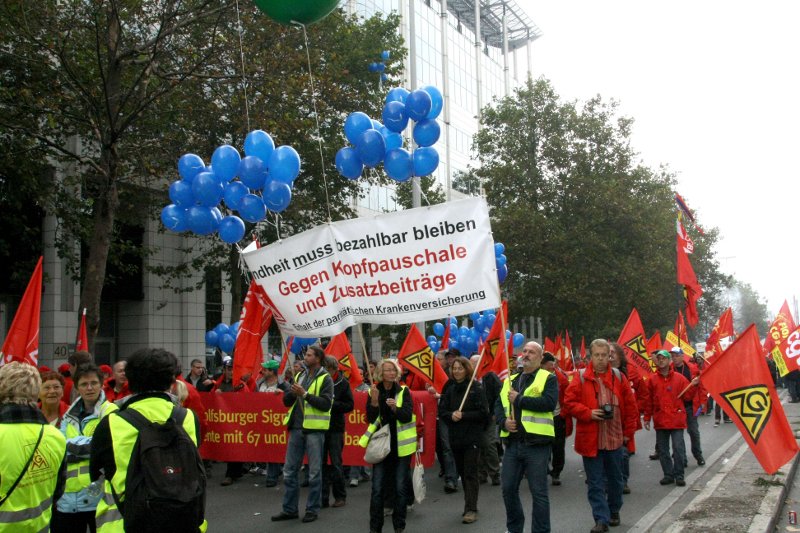 Smaller delegations came from the Netherlands, Britain, Spain, Greece, Italy, Ireland and Portugal. In all these countries the class struggle is also knocking at the door (see article by Alan Woods on the Day of Action). In all those countries, at different rhythms and paces the workers are starting to move. It is only the beginning but the fact cannot be denied: we are facing the slow but stubborn rise of the working class across the whole of Europe.
Smaller delegations came from the Netherlands, Britain, Spain, Greece, Italy, Ireland and Portugal. In all these countries the class struggle is also knocking at the door (see article by Alan Woods on the Day of Action). In all those countries, at different rhythms and paces the workers are starting to move. It is only the beginning but the fact cannot be denied: we are facing the slow but stubborn rise of the working class across the whole of Europe.
This movement is in desperate need of coordination at European level. The European TUC (ETUC) is not giving the slightest lead on this front. When the Greek and Irish workers were mobilising against the deep cuts in public spending the ETUC was nowhere to be seen. When a few months ago in Brussels some Greek youth organised a demonstration in solidarity with the general strike in their home country they asked an ETUC representative what they intended to do. “Haven’t you read our statement on the website?’ was his only reply. This shouldn’t surprise us. The ETUC is first of all not really a supranational union, not even a union in the real sense of the word. The ETUC is more like a lobby that is fully integrated into the structures and the bureaucratic labyrinth of the European Union. It is so well integrated that the ETUC receives 80% of its finances from the EU! Without wanting to exaggerate you could say that the ETUC it is “a department of the EU”. If the ETUC had wanted to put real pressure on the national governments to abandon their austerity plans it would have mobilised on a much larger scale. The European trade unions have millions of workers behind them, and it would not have been beyond their scope to get a turn-out of half a million workers in Brussels.
“Thanks for coming along”?
We have to add to all this the reformist outlook of the ETUC and the other national trade union leaders. Formally the Eurodemo was called to protest against “austerity” and in favour of “growth”. Some unions, however, had their own interpretation and changed the slogan to “protest against wild or severe austerity”.
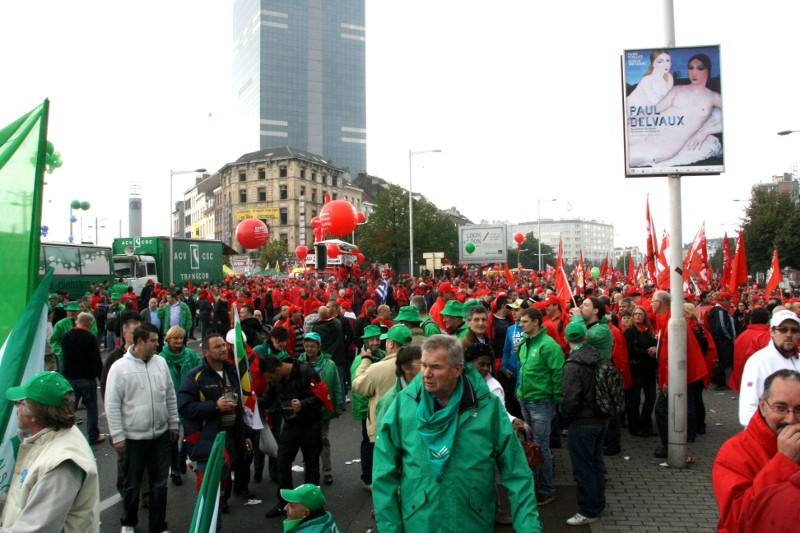 John Monks, the leader of the ETUC, declared on the same morning that the main question was the scope and the speed of the austerity measures not the austerity itself. “You really have to reschedule these debts so that they are not a huge burden on the next few years and cause Europe to plunge down into recession." He is in favour of a “rescheduled austerity”.
John Monks, the leader of the ETUC, declared on the same morning that the main question was the scope and the speed of the austerity measures not the austerity itself. “You really have to reschedule these debts so that they are not a huge burden on the next few years and cause Europe to plunge down into recession." He is in favour of a “rescheduled austerity”.
Thus, for these “leaders” it is not a question of opposing austerity, but of simply introducing it more slowly. They want to give the workers the same bitter medicine but in smaller doses spread out over a longer period, hoping that way the workers won’t get too militant. But why should the workers pay anything anyway? We think the workers should not pay for the crisis which is not of their making. The bankers and the bosses should pay!
Some other leaders of the left try to make the deep cuts acceptable by asking the rich politely to contribute (a little). The demand for a Tobin tax has come to the fore again or other such taxes on the rich. The recent revelations in Belgium that the steel giant Arcelor Mittal pays only 0.000038% taxes on its profits has provoked a lot of indignation amongst workers. However, while we would of course support taxes against the rich, such measures should not be applied as a means of getting workers to accept austerity. And we all know how the banks and the rich are very capable in engineering all kinds of legal loopholes to get out of paying taxes. The first serious step in “making the rich pay for their crisis” is to nationalise the banks under democratic workers’ control.
A socialist answer
From an economic point of view the proposals of the European trade unions are at best Keynesian. They want to kick start the economy by injecting public money into it. This is why they ask (again politely) the EU governments to invest in “growth”. But a reformist union leadership, even with a Keynesian outlook, faced with the pressure of “market realism” becomes the guardian of harsh austerity measures. One proof of this is the agreement between the Irish trade unions and the government on wage cuts. In the same way those governments in Europe, who at the beginning of the recession opposed cuts, have made a very rapid 180% turn. Not because of a whim of the bourgeois as the reformist leaders think, but because of the harsh necessities of a system in crisis. John Monks ended his short videoed speech in Brussels with a great perspective after this Day of Action. He just said, “Thanks for coming along”!!! In plain English this means: here we stop!
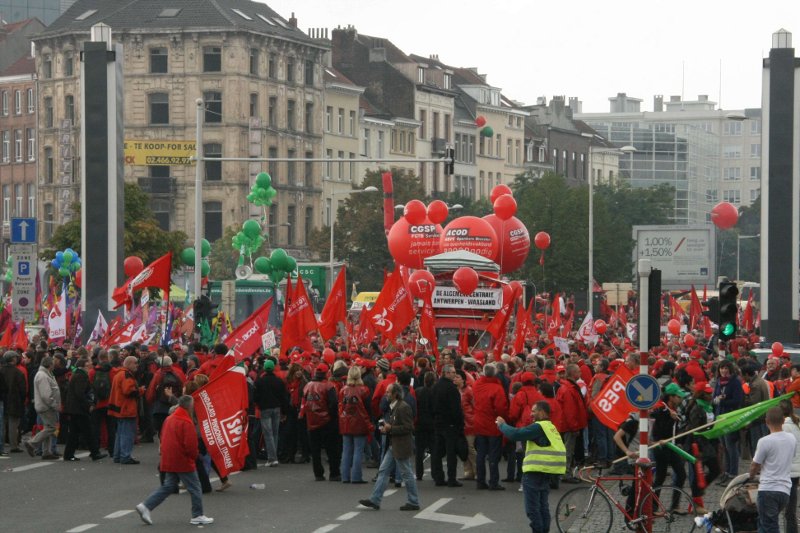 Would it not be better to prepare for a real one-day European-wide general strike against the cuts? This would be a show of strength of the working class and a way of uniting the different national struggles. Although a 24-hour general strike would not solve the problems of the workers, it would be a positive next step forward.
Would it not be better to prepare for a real one-day European-wide general strike against the cuts? This would be a show of strength of the working class and a way of uniting the different national struggles. Although a 24-hour general strike would not solve the problems of the workers, it would be a positive next step forward.
More importantly, however, is the need for a socialist solution to this crisis. The first condition for such an alternative is to reject all austerity and mobilise the workers and the youth to “make the rich and the bosses pay”. A central element in a socialist answer would be to call for the nationalisation of the banks in Europe under democratic workers’ control. By nationalising the banks you solve in great part the problem of the public debt which is in their hands. But other public debt to the rich and the bosses should not be paid back either (more information on our transitional demands you can find in our Manifesto; see The Crisis: Make the bosses pay!). The left mass parties in Europe who oppose the cuts should also call an all-European conference to give a socialist political voice to the trade union struggle and to help coordinate the separate national movements.
As anger against the austerity packages is growing amongst workers and their families, so will the search for an alternative to this decaying system. It is our job to convince them that socialism is the only solution.
Photo: Antonio Ponte.

